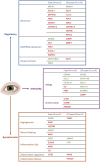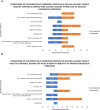What's the situation with ocular inflammation? A cross-seasonal investigation of proteomic changes in ocular allergy sufferers' tears in Victoria, Australia
- PMID: 38855108
- PMCID: PMC11157006
- DOI: 10.3389/fimmu.2024.1386344
What's the situation with ocular inflammation? A cross-seasonal investigation of proteomic changes in ocular allergy sufferers' tears in Victoria, Australia
Abstract
Background: Ocular allergy (OA) is a localized subset of allergy characterized by ocular surface itchiness, redness and inflammation. Inflammation and eye-rubbing, due to allergy-associated itch, are common in OA sufferers and may trigger changes to the ocular surface biochemistry. The primary aim of this study is to assess the differences in the human tear proteome between OA sufferers and Healthy Controls (HCs) across peak allergy season and off-peak season in Victoria, Australia.
Methods: 19 participants (14 OA sufferers, 5 HCs) aged 18-45 were recruited for this study. Participants were grouped based on allergy symptom assessment questionnaire scoring. Proteins were extracted from human tear samples and were run on an Orbitrap Mass Spectrometer. Peaks were matched to a DIA library. Data was analyzed using the software MaxQuant, Perseus and IBM SPSS.
Results: 1267 proteins were identified in tear samples of OA sufferers and HCs. 23 proteins were differentially expressed between peak allergy season OA suffers vs HCs, and 21 were differentially expressed in off-peak season. Decreased proteins in OA sufferers related to cell structure regulation, inflammatory regulation and antimicrobial regulation. In both seasons, OA sufferers were shown to have increased expression of proteins relating to inflammation, immune responses and cellular development.
Conclusion: Tear protein identification showed dysregulation of proteins involved in inflammation, immunity and cellular structures. Proteins relating to cellular structure may suggest a possible link between OA-associated itch and the subsequent ocular surface damage via eye-rubbing, while inflammatory and immune protein changes highlight potential diagnostic and therapeutic biomarkers of OA.
Keywords: allergic rhinoconjunctivitis; angiogenesis; human tears; inflammation; ocular allergy; protein biomarker; proteomics; wound healing.
Copyright © 2024 Aydin, Nie, Azizoglu, Chong, Gokhale and Suphioglu.
Conflict of interest statement
The authors declare that the research was conducted in the absence of any commercial or financial relationships that could be construed as a potential conflict of interest.
Figures




Similar articles
-
The Plight of the Metabolite: Oxidative Stress and Tear Film Destabilisation Evident in Ocular Allergy Sufferers across Seasons in Victoria, Australia.Int J Mol Sci. 2024 Apr 4;25(7):4019. doi: 10.3390/ijms25074019. Int J Mol Sci. 2024. PMID: 38612830 Free PMC article.
-
Comparison of tear proteome in allergic rhinoconjunctivitis patients and controls with respect to pollen season.Allergy. 2018 Jul;73(7):1541-1543. doi: 10.1111/all.13444. Epub 2018 Apr 15. Allergy. 2018. PMID: 29574764 Free PMC article. No abstract available.
-
A Review of Emerging Tear Proteomics Research on the Ocular Surface in Ocular Allergy.Biology (Basel). 2022 Feb 16;11(2):312. doi: 10.3390/biology11020312. Biology (Basel). 2022. PMID: 35205178 Free PMC article. Review.
-
Tear film function in patients with seasonal allergic conjunctivitis outside the pollen season.Int Arch Allergy Immunol. 2012;157(1):81-8. doi: 10.1159/000324657. Epub 2011 Sep 7. Int Arch Allergy Immunol. 2012. PMID: 21912177
-
Allergy and allergic mediators in tears.Exp Eye Res. 2013 Dec;117:106-17. doi: 10.1016/j.exer.2013.07.019. Epub 2013 Jul 25. Exp Eye Res. 2013. PMID: 23891862 Review.
References
-
- Health conditions prevalence (2023). Australian Bureau of Statistics. Available online at: https://www.abs.gov.au/statistics/health/health-conditions-and-risks/hea... (Accessed 21 February 2024).
MeSH terms
Substances
LinkOut - more resources
Full Text Sources
Medical
Research Materials

